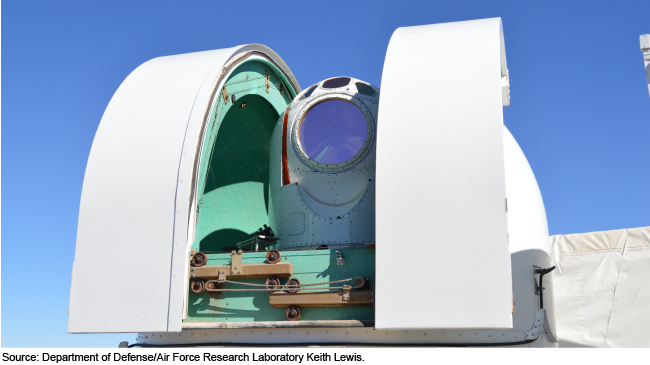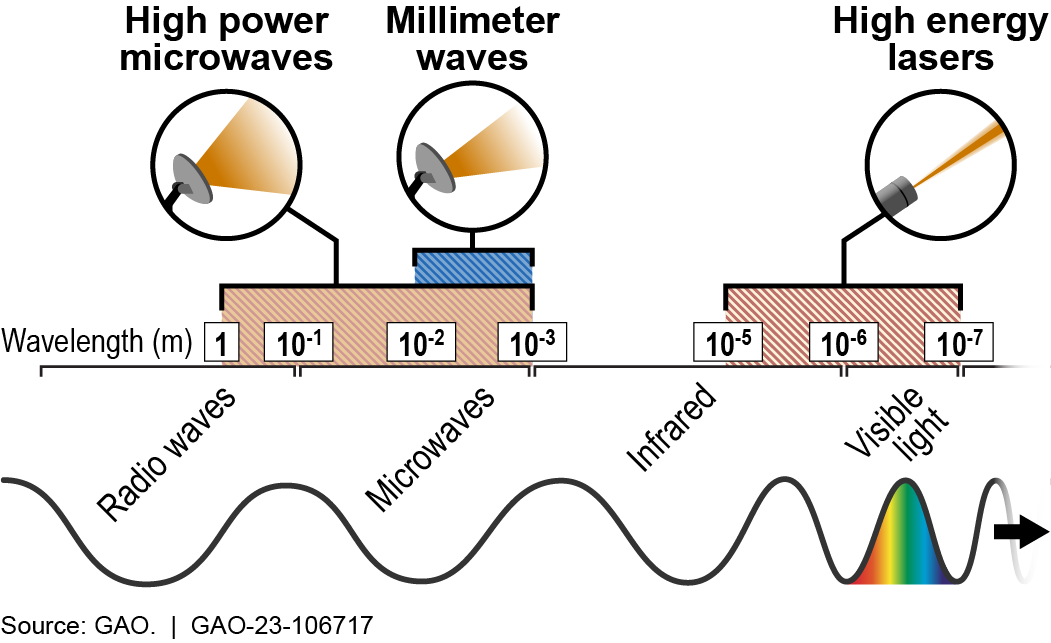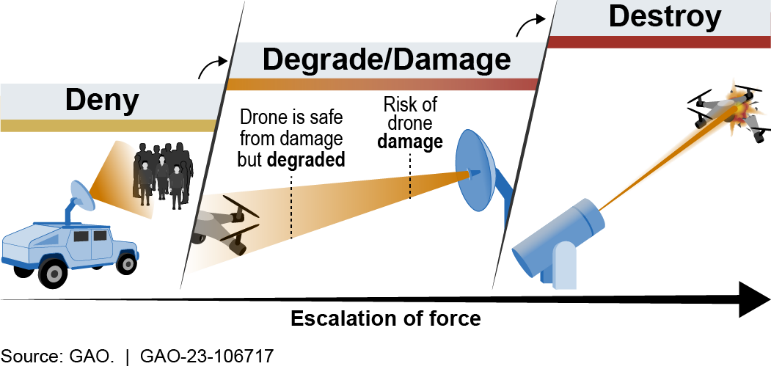Directed Energy Weapons Move from Lab to Battlefield as Counter-Drone Systems Mature
Major defense contractors are rapidly transitioning directed energy weapons (DEW) from experimental technology to operational systems, with counter-drone missions driving deployment.
The U.S. military has achieved significant breakthroughs in both high-energy laser and high-power microwave systems. Lockheed Martin's 150kW LWSD laser system is operational on USS Portland, while Raytheon's THOR microwave system has demonstrated capability against drone swarms. The Army's HEL TVD program aims to field 300kW vehicle-mounted lasers by 2024.
"These weapons offer capabilities that conventional weapons may not," reports the GAO, citing precision effects, low cost per shot, and rapid engagement of multiple targets. Current systems can engage drones at ranges up to 7km, though effectiveness varies with weather conditions.
Key developments include:
- - Solid-state lasers achieving 30-300kW power levels
- - Combined laser/microwave systems for layered defense
- - Mobile, tactical platforms for field deployment
- - Advanced beam control and targeting systems
The Pentagon has maintained $1 billion annual investment in DEW since 2021. Primary applications focus on:
- - Base and ship defense against drones
- - Counter-swarm capabilities
- - Non-lethal engagement options
- - Precision strikes with minimal collateral damage
The emergence of "Havana Syndrome" incidents has also spurred research into scalar wave technology that could potentially penetrate traditional defenses.
With drone threats increasing globally, military planners see DEW systems becoming a critical layer in air defense alongside conventional weapons. Major contractors are now focusing on ruggedization and integration of proven technologies for operational deployment..
DEW Systems
US Navy:
- - LWSD (150kW): Most powerful deployed naval laser system, mounted on USS Portland. Successfully destroyed aerial drones in 2020 testing and participated in Pacific exercises. Uses solid-state laser technology with growth potential to 300kW.
- - ODIN: First laser dazzling weapon deployed in combat. Installed on USS Dewey in 2019, designed to blind drone sensors and optronics. Three more systems planned by 2023.
- - HELIOS: Next-generation 150kW system combining counter-ISR and counter-UAS capabilities. Planned integration on Arleigh Burke destroyers starting 2021, marking first permanent ship laser installation.
US Army:
- - HEL TVD: Mobile 100kW laser mounted on heavy tactical vehicle. In prototype phase, designed for base defense and counter-UAS. Plans to increase power to 300kW by 2024.
- - MEHEL: Test platform integrating 2-50kW lasers on Stryker vehicles. Successfully demonstrated against Class I and II drones at White Sands, proving mobile laser concept.
- - MMHEL: Multi-mission system combining detection, tracking and high-energy laser. Designed for air defense against drones, rockets, artillery and mortars.
US Air Force:
- - SHIELD: Pod-mounted airborne laser for fighter aircraft self-protection. Ground testing completed, first flight tests planned 2023. Represents first tactical airborne laser weapon.
- - THOR: High-power microwave system specifically for drone swarms. Container-based system demonstrated ability to defeat 50+ drones simultaneously. Deployed to Africa for testing.
- - HELWS: Raytheon's compact 10kW laser integrated on MRZR all-terrain vehicle. Demonstrated 12 drone kills in testing. Focused on mobility and rapid deployment.
Major Contractors:
- - Lockheed Martin: Leading HELIOS program and developing scalable fiber laser technology. Achieved 300kW demonstration in lab testing.
- - Raytheon: Pioneering combined laser/microwave approach with HELWS and Phaser systems. Focuses on mobile, tactical systems.
- - Northrop Grumman: Developing next-generation solid-state laser technology. Achieved breakthrough in beam quality and power scaling.
Technology Maturity:
- - Solid-state lasers now reliable at 30-300kW range. Improvements in beam quality and thermal management enable practical weapons.
- - Demonstrated drone kills at 7km range through varied weather conditions. Tracking and targeting systems proven effective.
- - Microwave systems proven against swarms but range limited to hundreds of meters. Working to extend effective radius.
- - Weather remains key limitation - fog, rain, dust degrade laser performance. Research ongoing into atmospheric compensation.
Combat Roles:
- - Counter-UAS primary mission with demonstrated effectiveness against commercial and military drones. Provides low-cost-per-shot defense.
- - Base and ship defense benefiting from deep magazines and rapid engagement capability. No ammunition logistics required.
- - Non-lethal engagement through dazzling and electronics disruption provides graduated response options.
- - Multiple target engagement via wide-area microwave effects deals with swarm attacks cost-effectively.
Space Applications
Several counter-space applications are known open source, though they receive less focus than counter-drone missions:
- Historical Programs:
- - Soviet Union and US tested high-power lasers against satellites during Cold War
- - US Strategic Defense Initiative (SDI) included particle beam weapons for missile/satellite defense
- Current Development:
- - US Navy's SNLWS program has potential anti-satellite capabilities at higher power levels
- - Russia's Peresvet laser system reportedly has satellite-blinding capabilities
- - US Air Force researching space-based laser applications for satellite defense
- Limitations noted:
- - Atmospheric effects limit ground-based laser effectiveness against satellites
- - International treaties and space law considerations restrict some applications
- - Power scaling needed for effective satellite engagement from ground
However, most current DEW development appears focused on shorter-range tactical applications like counter-UAS rather than strategic space defense.
GAO DEW Fast Facts
Directed energy weapons—such as lasers—use energy fired at the speed of light. These weapons can produce force that ranges from deterrent, to damaging, to destructive. Many countries, including the U.S., are researching their use.
Because they use energy instead of bullets or missiles, directed energy weapons could be less expensive per shot and have virtually unlimited firing power.
However, the long-term health effects of these weapons are unclear. They also generally have a shorter range than conventional weapons, and weather conditions—such as fog and storms—can make certain directed energy weapons less effective.
Demonstrator Laser Weapon System at the White Sands Missile Range, New Mexico

Highlights
Why This Matters
There is a surge in interest in directed energy weapons from several nations—including the U.S.—primarily for counter drone missions. These weapons use electromagnetic energy to cause effects ranging from deterrence to destruction. They offer capabilities that conventional weapons may not, but challenges have so far prevented widespread operational use.
The Technology
What is it? Directed energy weapons (DEW) use concentrated electromagnetic energy to combat enemy forces and assets. These weapons include high energy lasers and other high power electromagnetics—such as millimeter wave and high power microwave weapons. Unlike weapons that fire bullets or missiles, DEWs can respond to a threat in different ways. For example, they can temporarily degrade electronics on a drone or physically destroy it. See our 2022 Spotlight for more information on counter-drone technology.
How does it work? Each type of DEW uses a different region of the electromagnetic spectrum (see fig. 1). This spectrum describes all of the kinds of light—including those the human eye cannot see—and classifies them according to wavelength. Different types of electromagnetic energy have different properties. For example, the wavelength affects what the directed energy can penetrate—such as metal or human skin.

Figure 1. Location of directed energy weapons on the electromagnetic spectrum.
All DEWs emit energy at the speed of light, and are often discussed in terms of their power output—the amount of electromagnetic energy transferred over time. While DEWs use electromagnetic energy similar to everyday items, such as household microwaves, their power output is vastly higher, as described below.
High energy lasers produce a very narrow beam of light, usually in the infrared to visible region, and are typically used on one target at a time. The beam can be pulsed or continuous, generating a power output of at least 1 kilowatt. This output is 200,000 times greater than a typical laser pointer and is capable of melting steel.
Millimeter wave weapons have wavelengths between 1 and 10 millimeters and generate more than 1 kilowatt of power. Millimeter wave weapons have a larger beam size than high energy lasers and therefore can affect multiple targets at once.
High power microwave weapons produce microwaves, which have longer wavelengths than high energy lasers and millimeter wave weapons. These weapons can produce more than 100 megawatts of power, which is nearly 150,000 times more powerful than the average household microwave. Like millimeter wave weapons, they can also affect multiple targets because of their larger beam size.
Each DEW can produce a range of effects from nonlethal to lethal, depending on factors such as the time on target, the distance to the target, and even the part of the target on which the DEW is focused. DEWs can use this range of effects to graduate responses to a threat. A graduated response could start with temporarily preventing use of an asset or its access to an area and increase to destruction of the asset if necessary (see fig. 2).

Figure 2. Examples of graduated responses using directed energy weapons.
DEWs can deny entrance to an area or prevent enemy forces or assets from functioning within an area. DEWs used for denial do not cause long-term damage to targets, and when enemy forces or assets leave the area, they typically regain function or the effect is mitigated. For example, the Department of Defense's (DOD) Active Denial System uses millimeter waves that interact with the water and fat molecules in a person's skin to create a heating sensation. During testing, the discomfort persuaded individuals to move away from the area.
DEWs can also degrade the efficacy of an enemy's assets. For example, high energy lasers can temporarily overwhelm a person or a sensor's ability to see or sense by emitting a glare—called dazzling. Dazzling can act as a non-verbal warning before resorting to increased force.
If a greater amount of force is required, DEWs can also damage or destroy enemy assets. To do this, a high energy laser can emit electromagnetic energy with a wavelength the target material absorbs most effectively, melting the material. The laser could focus on a sensor and damage a drone, or focus on a fuel tank or battery and destroy it.
How mature is it? DEWs range in maturity from research projects to prototypes tested in the field. DOD named DEWs as a technology critical to enabling the 2018 National Defense Strategy and reported spending about $1 billion annually for the last 3 years on research and development. The U.S. military has tested a variety of DEW prototypes since 2014, primarily for counter-drone missions. For example, the Air Force’s prototype Tactical High Power Microwave Operational Responder (THOR) recently completed 2 years of testing. DOD is researching ways to increase the power output of DEWs to engage more powerful targets—like missiles. However, as GAO recently reported, the U.S. military faces challenges bridging the gap between DEW development and acquisition, potentially limiting widespread operational use.
Why now? DEW research and development has been ongoing for decades in many countries—including the U.S.—and is currently experiencing a surge worldwide. This surge stems in part from advances in technology and a desire to maintain competitiveness on the battlefield. Technological innovations, such as the development of smaller lasers that are safer to operate, enable modern DEWs to be much more portable and practical. For example, a four-wheel all-terrain vehicle can now hold a high energy laser powerful enough to damage drones. The U.S. and 30 other nations are developing DEWs, most for counter-drone missions, according to a 2021 Air Force report.
Opportunities
- Complement to conventional weapons. DEWs use energy fired at the speed of light, making them faster and potentially less costly per shot than missiles. Some DEWs have virtually unlimited ammunition and can fire as long as they have power.
- Ease of graduated response. DOD can tailor DEWs to meet mission needs from nonlethal to lethal responses. For example, the longer a laser is focused on target, the more damage or destruction will occur.
- Advancing other uses. Research and development for DEWs could also benefit civilian uses. For example, the development of higher energy lasers could help projects that use directed energy to transport or “beam” power to remote and disadvantaged locations.
Challenges
- Technological limitations. DEWs are generally less effective the farther they are from the target, and atmospheric conditions and cooling requirements can limit their effectiveness. For example, fog and storms can reduce laser beam range and quality.
- Battlefield use. Decisions about how and when to use DEWs or conventional weapons may be challenging. For example, wider beam DEWs, such as high power microwave or millimeter wave weapons, affect all assets in an area, whether friend or foe.
- Ethical and health concerns. Although there are potentially relevant international laws and guidelines, their applicability to DEWs is not always well defined. Uncertainty around long-term health effects of DEWs on people either intentionally or unintentionally exposed to directed energy has led to concerns regarding the ethics of using DEWs.
Policy Context and Questions
- As the technology matures, what actions could policymakers take to help bridge the gap between DEW development and acquisition?
- What actions could policymakers take to ensure there is appropriate guidance for using DEWs as the technology matures?
- What are the trade-offs of using nonlethal DEW technologies before potential health effects are fully understood?
For more information, contact: Brian Bothwell at (202) 512-6888 or bothwellb@gao.gov.
Overview of directed energy weapon developments | IEEE Conference Publication | IEEE Xplore
T. H. G. G. Weise, M. Jung, D. Langhans and M. Gowin, "Overview of directed energy weapon developments," 2004 12th Symposium on Electromagnetic Launch Technology, Snowbird, UT, USA, 2004, pp. 483-489, doi: 10.1109/ELT.2004.1398128.
Abstract:
In future defence scenarios directed energy weapons are of increasing
interest. Therefore national and international R&D programs are
increasing their activities on laser and high power microwave
technologies in the defence and anti terror areas. The paper gives an
overview of the German R&D programmes on directed energy weapons. A
solid state medium energy weapon laser (MEL) is investigated at
Rheinmetall for i.e. anti air defence applications up to distances of
about 7 km. Due to the small volume these Lasers can be integrated as a
secondary weapon system into mobile platforms such as AECVs. The beam
power of a MEL is between 1 kW and 100 kW. The electric energy per pulse
is in the kJ range. A burst of only a few pulses is needed to destroy
optronics of targets in a distance up to 7 km. The electric energy
requirements of a MEL system are low. High energy density pulsed power
technologies are already available for the integration into a medium
sized vehicle. The paper gives an overview on the MEL technologies which
are under investigation in order to introduce a technology demonstrator
at the end of 2005. The electric requirements at the interface to the
power bus of a vehicle are presented. Finally an integration concept as a
secondary weapon in a medium sized vehicle is given and discussed. In
close cooperation with Diehl Munitionssysteme high power microwave
technologies are investigated. Different kinds of HPM Sources are under
development for defence and anti terror applications. It is the goal to
introduce first prototype systems within a short time frame. The paper
gives a brief overview on the different source technologies currently
under investigation. The joint program concentrates on ultra wide band
and damped sinus HPM waveforms in single shot and repetitive operation.
Radiation powers up to the Gigawatt range are realized up to now. By
presenting some characteristic scenarios for those HPM systems the wide
range of applications is proven in the paper.
keywords: {Weapons;Microwave technology;Vehicles;Paper technology;Research and development;Masers;Power lasers;Solid state circuits;Solid lasers;Laser beams},
URL: https://ieeexplore.ieee.org/stamp/stamp.jsp?tp=&arnumber=1398128&isnumber=30395



No comments:
Post a Comment